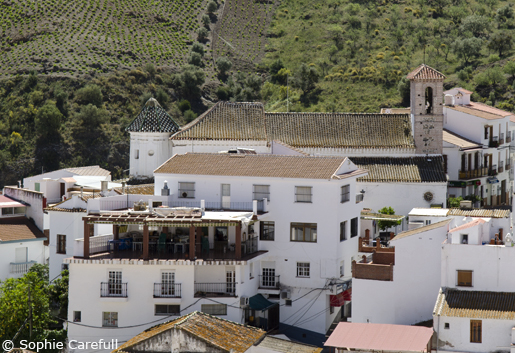 |
| The village of Almachar on the Ruta de la Pasa (Raisin Route) in Malaga province. |
The banks of the river that runs by Almáchar have vineyards, olive groves, wheat fields and small orchards; at farmhouses, grapes are made into raisins using traditional methods - laying them out to dry in beds. The town is one of several making up the Ruta de la Pasa (Raisin route). Its name comes form the Arabic word "machar", which means meadow.
For a personal service from start to finish and afterwards too. Give us a call +34 618 295 063
Like many other towns within the Axarquía comarca (group of towns), you can see, in Almáchar, the Arabic style construction with its narrow, steep, winding streets, leading to low, whitewashed houses. Look out for calle Mártires, which circles the most recognised building of the town - the Iglesia de San Mateo (Saint Matthews church). This temple, located in the town centre, was constructed in the 17th century and was built following the style guidelines set by late-Gothic and Renaissance architects. Connected to the church's exterior is a square Moorish tower.
Book your stay in Andalucia Now!
Other places of interest are the Plaza del Pueblo (town square) where, if you look in the direction of El Borge village, you get a beautiful, panoramic view; the Cueva del Toro (the Bull's Cave), found on the outskirts of the town; the Museo de la Pasa (Raisin Museum), which is considered of archaeological interest; and the town fountain where according to the local legend, the Moors buried their treasures before being expelled from the land.
The Almachereños are specialists in cooking up the famous ajoblanco (almond and garlic soup) and, on the first Saturday of September, the town celebrates this rich provincial dish. But there is more to be offered than just ajoblanco. Other traditional local dishes are the berzas de coles (stew of potatoes, beans, chickpeas and cabbage, with ham, bacon or veal), puchero (meat, vegetable and pulse stew), gazpacho (chilled vegetable soup) and sopa amarilla (pumpkin and carrot soup). All of these should be enjoyed with a glass of delicious muscatel wine, produced locally in a traditional way.
There are many opportunities throughout the year to experience the town's fiestas and ferias. Santo Cristo de la Banda Verde has been celebrated since 1754 and takes place on the first weekend of May. Like most festivals, its origins are religious, but it also features music and dance performances, firework displays and sporting competitions. The traditional Romeria de San Isidro takes place on 15 May. The Fiesta de Nuestra Señora del Amparo, held on the last weekend of July, celebrates the patron of the town. On the first Saturday of September, there is the Fiesta del Ajoblanco, directly followed by the Fiesta de Candelas, which starts at midnight after the Fiesta del Ajoblanco. Each year this celebration - declared to be of national touristic interest - attracts many visitors wanting to try this tasty recipe, and also those who just want to enjoy all the cultural and festive activities on offer that make these fiestas so enjoyable.
As well as being the land of the raisins, Almáchar is also the land of legends. One of these (mentioned briefly above) tells of a cave located beneath the town's fountain, near the Almáchar River. It was supposedly built by the Moors to bury their gold and jewels when they left the town, after the Christian reconquest. Another local tale is that Cristo de la Banda Verde, or the Misericorida (the merciful one), saved seaman who were shipwrecked after a heavy storm off the coast of Malaga.
Almáchar is located around 24km from Velez-Malaga and 26km from the Malaga city.

